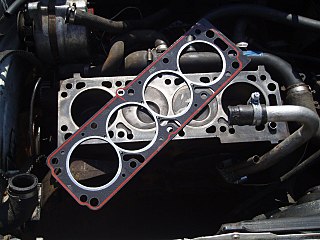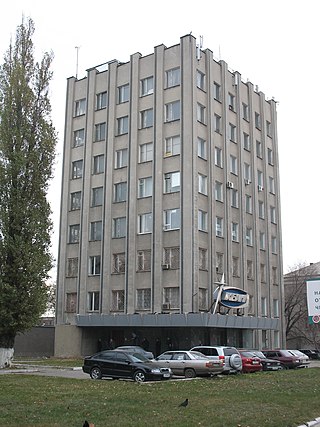
A hybrid-propellant rocket is a rocket with a rocket motor that uses rocket propellants in two different phases: one solid and the other either gas or liquid. The hybrid rocket concept can be traced back to the early 1930s.

A scramjet is a variant of a ramjet airbreathing jet engine in which combustion takes place in supersonic airflow. As in ramjets, a scramjet relies on high vehicle speed to compress the incoming air forcefully before combustion, but whereas a ramjet decelerates the air to subsonic velocities before combustion using shock cones, a scramjet has no shock cone and slows the airflow using shockwaves produced by its ignition source in place of a shock cone. This allows the scramjet to operate efficiently at extremely high speeds.

A rocket engine uses stored rocket propellants as the reaction mass for forming a high-speed propulsive jet of fluid, usually high-temperature gas. Rocket engines are reaction engines, producing thrust by ejecting mass rearward, in accordance with Newton's third law. Most rocket engines use the combustion of reactive chemicals to supply the necessary energy, but non-combusting forms such as cold gas thrusters and nuclear thermal rockets also exist. Vehicles propelled by rocket engines are commonly used by ballistic missiles and rockets. Rocket vehicles carry their own oxidiser, unlike most combustion engines, so rocket engines can be used in a vacuum to propel spacecraft and ballistic missiles.

The RS-25, also known as the Space Shuttle Main Engine (SSME), is a liquid-fuel cryogenic rocket engine that was used on NASA's Space Shuttle and is used on the Space Launch System (SLS).

The John C. Stennis Space Center (SSC) is a NASA rocket testing facility in Hancock County, Mississippi, United States, on the banks of the Pearl River at the Mississippi–Louisiana border. As of 2012, it is NASA's largest rocket engine test facility. There are over 50 local, state, national, international, private, and public companies and agencies using SSC for their rocket testing facilities.

The J-2, commonly known as Rocketdyne J-2, was a liquid-fuel cryogenic rocket engine used on NASA's Saturn IB and Saturn V launch vehicles. Built in the United States by Rocketdyne, the J-2 burned cryogenic liquid hydrogen (LH2) and liquid oxygen (LOX) propellants, with each engine producing 1,033.1 kN (232,250 lbf) of thrust in vacuum. The engine's preliminary design dates back to recommendations of the 1959 Silverstein Committee. Rocketdyne won approval to develop the J-2 in June 1960 and the first flight, AS-201, occurred on 26 February 1966. The J-2 underwent several minor upgrades over its operational history to improve the engine's performance, with two major upgrade programs, the de Laval nozzle-type J-2S and aerospike-type J-2T, which were cancelled after the conclusion of the Apollo program.

The staged combustion cycle is a power cycle of a bipropellant rocket engine. In the staged combustion cycle, propellant flows through multiple combustion chambers, and is thus combusted in stages. The main advantage relative to other rocket engine power cycles is high fuel efficiency, measured through specific impulse, while its main disadvantage is engineering complexity.
In rocket engine design, regenerative cooling is a configuration in which some or all of the propellant is passed through tubes, channels, or in a jacket around the combustion chamber or nozzle to cool the engine. This is effective because the propellants are often cryogenic. The heated propellant is then fed into a special gas-generator or injected directly into the main combustion chamber.

The RD-170 is the world's most powerful and heaviest liquid-fuel rocket engine. It was designed and produced in the Soviet Union by NPO Energomash for use with the Energia launch vehicle. The engine burns kerosene fuel and LOX oxidizer in four combustion chambers, all supplied by one single-shaft, single-turbine turbopump rated at 170 MW (230,000 hp) in a staged combustion cycle.

In an internal combustion engine, a head gasket provides the seal between the engine block and cylinder head(s).
An engine test stand is a facility used to develop, characterize and test engines. The facility, often offered as a product to automotive OEMs, allows engine operation in different operating regimes and offers measurement of several physical variables associated with the engine operation.

Rocket Engine Test Facility was the name of a facility at the NASA Glenn Research Center, formerly known as the Lewis Research Center, in Ohio. The purpose of the Rocket Engine Test Facility was to test full-scale liquid hydrogen rockets at thrust chamber pressures of up to 2100 psia and thrust levels to at least 20,000 pounds. Work on the design of the facility began in 1954 under the auspices of NACA's Rocket Branch of the Fuels and Combustion Research Division. It was built at a cost of $2.5 million and completed in 1957. The facility was located at the south end of the center, adjacent to Abrams Creek 41.404°N 81.868°W. It was demolished in 2003 in order to make way for the runway expansion of the Cleveland Hopkins International Airport.

Chemical Automatics Design Bureau (CADB), also KB Khimavtomatika, is a Russian design bureau founded by the NKAP in 1941 and led by Semyon Kosberg until his death in 1965. Its origin dates back to a 1940 Moscow carburetor factory, evacuated to Berdsk in 1941, and then relocated to Voronezh city in 1945, where it now operates. Originally designated OKB-296 and tasked to develop fuel equipment for aviation engines, it was redesignated OKB-154 in 1946.

The Armstrong Siddeley, later Bristol SiddeleyGamma was a family of rocket engines used in British rocketry, including the Black Knight and Black Arrow launch vehicles. They burned kerosene fuel and hydrogen peroxide. Their construction was based on a common combustion chamber design, used either singly or in clusters of up to eight.

Launch Complex 11 (LC-11) at Cape Canaveral Space Force Station, Florida, is a launch complex used by Atlas missiles between 1958 and 1964. It is the southernmost of the launch pads known as Missile Row. When it was built, it, along with complexes 12, 13 and 14, featured a more robust design than many contemporary pads, due to the greater power of the Atlas compared to other rockets of the time. It was larger, and featured a concrete launch pedestal that was 6 metres (20 ft) tall and a reinforced blockhouse. The rockets were delivered to the launch pad by a ramp on the southwest side of the launch pedestal.

MAHLE Powertrain Ltd is the engineering services division of MAHLE GmbH. With its headquarters in Northampton, UK and sister company in Plymouth, Michigan, United States, the company specialises in the design, development and testing of electrified powertrain systems and provides a broad spectrum of engineering services to its global customer base. MAHLE Powertrain's engineers and technical specialists are also present in the MAHLE research and development centres in Munich, Germany and Shanghai, China.

An internal combustion engine is a heat engine in which the combustion of a fuel occurs with an oxidizer in a combustion chamber that is an integral part of the working fluid flow circuit. In an internal combustion engine, the expansion of the high-temperature and high-pressure gases produced by combustion applies direct force to some component of the engine. The force is typically applied to pistons, turbine blades, a rotor, or a nozzle. This force moves the component over a distance. This process transforms chemical energy into kinetic energy which is used to propel, move or power whatever the engine is attached to.

The BE-4 is an oxygen-rich liquefied-methane-fueled staged-combustion rocket engine produced by Blue Origin. The BE-4 was developed with private and public funding. The engine has been designed to produce 2.4 meganewtons (550,000 lbf) of thrust at sea level.
The Institute of Space Propulsion in Lampoldshausen is one of the eight research centers of the German Aerospace Center (DLR).

Raptor is a family of rocket engines developed and manufactured by SpaceX. It is the third rocket engine in history designed with a full-flow staged combustion (FFSC) fuel cycle, and the first such engine to power a vehicle in flight. The engine is powered by cryogenic liquid methane and liquid oxygen, a mixture known as methalox.
















